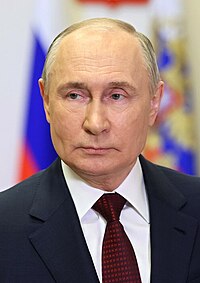
Back President d'a Federación de Rusia AN رئيس روسيا Arabic رئيس روسيا ARZ Presidente de Rusia AST Россиялъул Федерациялъул президент AV Rusiya Prezidenti Azerbaijani Рәсәй Президенты Bashkir Прэзідэнт Расіі Byelorussian Прэзыдэнт Расеі BE-X-OLD Президент на Русия Bulgarian
| President of the Russian Federation | |
|---|---|
| Президент Российской Федерации | |
 Presidential emblem | |
 | |
since 7 May 2012 | |
| Presidential Administration of Russia | |
| Style | Mr President (informal) Comrade Supreme Commander (military) His Excellency[1] (diplomatic) |
| Type | President |
| Status | Head of state Commander-in-chief |
| Member of | |
| Residence |
|
| Seat | Kremlin Senate |
| Appointer | Direct popular vote |
| Term length | Six years |
| Constituting instrument | Constitution of Russia |
| Precursor | President of the Soviet Union |
| Formation | |
| First holder | Boris Yeltsin |
| Deputy | Prime Minister |
| Salary | 8,900,000₽ or US$120,000 per annum est.[4] |
| Website | президент.рф (in Russian) eng.kremlin.ru (in English) |
The President of the Russian Federation (Russian: Президент Российской Федерации, romanized: Prezident Rossiyskoy Federatsii) is the executive head of state of Russia. The president is the chair of the Federal State Council and the supreme commander-in-chief of the Russian Armed Forces. It is the highest office in Russia.
The modern incarnation of the office emerged from the president of the Russian Soviet Federative Socialist Republic (RSFSR). In 1991, Boris Yeltsin was elected president of the RSFSR, becoming the first non-Communist Party member to be elected into a major Soviet political role. He played a crucial role in the dissolution of the Soviet Union which saw the transformation of the RSFSR into the Russian Federation. Following a series of scandals and doubts about his leadership, violence erupted across Moscow in the 1993 Russian constitutional crisis. As a result, a new constitution was implemented and the 1993 Russian Constitution remains in force today. The constitution establishes Russia as a semi-presidential system which separates the president of Russia from the government of Russia which exercises executive power.[5]
In all cases where the president of the Russian Federation is unable to fulfill their duties, those duties shall be temporarily delegated to the prime minister of Russia, who becomes acting president of Russia.[6]
The powers of the presidency include: execution of federal law, appointing federal ministers, and members of the judiciary, and negotiating treaties with foreign powers. The president also has the power to grant federal pardons and reprieves, and to convene and adjourn the Federal Assembly under extraordinary circumstances. The president also appoints the prime minister, who directs domestic policy of the Russian Federation alongside the president.
The president is elected directly through a popular vote to a six-year term. Previously, the Constitution established a term limit for the presidency restricting the officeholder to serve no more than two consecutive terms. However, this limitation has since been overhauled in large part due to the constitutional amendments that were ratified in 2020. One of the amendments passed reset the terms of both Vladimir Putin and Dmitry Medvedev, allowing either to serve as president for a full two terms regardless of their previous terms. In all, three individuals have served four presidencies spanning six full terms. In May 2012, Vladimir Putin became the fourth president; he was re-elected in March 2018 and in March 2024 for two consecutive six-year terms.
- ^ United Nations Heads of State Heads of Government Ministers for Foreign Affairs Protocol and Liaison Service
- ^ RSFSR Law "On President of the Russian SFSR
- ^ RSFSR Law on amendments to the Constitution of the RSFSR
- ^ "Here are the salaries of 13 major world leaders". Archived from the original on 30 September 2018. Retrieved 8 February 2020.
- ^ I.E. Kozlova and O. E. Kutafin, Konstitutsionnoe Pravo Rossii (Constitutional Law of Russia) (4th ed, 2006) p. 383
- ^ "Конституция Российской Федерации". Eng.constitution.kremlin.ru. Archived from the original on 10 May 2013. Retrieved 3 March 2014.
